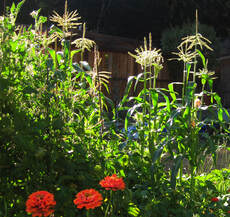|
expanded 5/2021 Summer favorites differ from spring and fall crops in more ways than their temperature range. They actually come from different parts of the world, with different kinds of soil and growing patterns. If you understand those differences, it will help you to grow them with more success and a lot less effort. Think of the vegetables of spring and fall—lettuce, peas, fava beans, cabbage, broccoli, kale, radishes, spinach--even wheat, barley, and rye grains. Every single one comes from Europe, which has a moderate climate like our Pacific Northwest. European crops primarily evolved from maritime and cool-climate plants, under traditional mixed-farming conditions. Livestock like cattle, sheep and pigs were integral to farming. Permanent fields were plowed with heavy doses of animal manure and matured during a temperate summer. In the warm Mediterranean regions with dry summers, they were all grown as winter crops. In contrast, most of our hot-weather crops--beans, corn, tomatoes, peppers, zucchini, potatoes, squash, watermelon, and okra, sorghum, amaranth, millet, and quinoa--all come from North America, South America, or Africa. The hoe, digging stick, and fire were the primary tools used to prepare the ground. The fields were carved out of jungle or brush, used for a few seasons, and left fallow. Their fallow period was not as pasture, as in Europe, but as forest. The primary sources of nutrients were the ash from burning, and the decomposed forest vegetation from clearing the land. Crops were sown in place rather than transplanted, and cultivated with hand tools, not draft animals. In some places, they were planted, then left while the farmer went hunting or gathering elsewhere, to return for harvest. Many are extremely vigorous, to overtop or clamber over logs and debris. Look at those sunflowers, corn, and amaranth plants at Golden Rule Garden, above. These are plants that use sunlight and heat to power explosive growth. What does this mean for us? I've realized more and more that these crops are at home in our backyards: They evolved with hot weather, small plots, and hand labor. They are forgiving of neglect. Sounds like my garden!
Peppers are New World plants that come from riverside thickets and arroyos. They do best growing close together on light, fine-textured soil; a bed works better for them than rows. I've had great success growing them in a dozen pots pushed close together. (Potting mix is perfect for their small, non-aggressive root systems.) The top canopy should get full sun, but not the sides of the plants--it scalds the fruits. I like to plant basil or other herbs around the edge of a pepper bed to prevent sunscald. In some traditions, they were grown either in with other creekside plants like wolfberries, or in the light shade of mesquite trees.  A three Sisters garden with pole beans growing up corn, squash at their feet, and zinnias attracting pollinators. All of these plants are native to the Americas, and have been grown together for millennia. A grouping like this is easy in a home garden, difficult or impossible in large-scale farming.
5 Comments
|
AuthorJamie Chevalier lives and gardens on a river in the Coast Range of Northern California. She has gardened professionally in Alaska and California, as well as living in a remote cabin, commercial fishing, and working with seeds. She is the proprietor of Quail Seeds. Archives
July 2024
|
- Home
-
Shop
- Plant for Summer
-
Vegetable Seeds
>
- Arugula
- Beans
- Beets
- Broccoli and Cima di Rapa
- Cabbage
- Carrots & Roots
- Celery
- Chard
- Corn
- Cucumber
- Eggplant
- Fennel
- Genepools and Landrace Gardening
- Greens
- Kale and Collards
- Lettuce
- Melons
- Oil Crops
- Okra
- Open-Source Seeds (OSSI)
- Onions and Leeks
- Peas
- Peppers
- Spinach
- Squash & Pumpkins
- Sunflowers
- Tomatoes
- Tomatillos/Husk Cherries
- Turnips and Rutabagas
- Perennial Vegetables >
- Flower Seeds
- Herb Seeds >
- Seed Collections
- Pollinator and Pest Control Plants >
- Grains >
- Cover Crops >
- Open Source (OSSI)
- Start these Indoors
- People behind the Seeds >
- Companion Plants
- Recipes >
- Fast, Fresh Food
- Plant for Spring >
- Plant for Fall >
- About Us.
- Blog
- HOW-TO
- Mid-to-Late Summer Sowings
Proudly powered by Weebly
- Home
-
Shop
- Plant for Summer
-
Vegetable Seeds
>
- Arugula
- Beans
- Beets
- Broccoli and Cima di Rapa
- Cabbage
- Carrots & Roots
- Celery
- Chard
- Corn
- Cucumber
- Eggplant
- Fennel
- Genepools and Landrace Gardening
- Greens
- Kale and Collards
- Lettuce
- Melons
- Oil Crops
- Okra
- Open-Source Seeds (OSSI)
- Onions and Leeks
- Peas
- Peppers
- Spinach
- Squash & Pumpkins
- Sunflowers
- Tomatoes
- Tomatillos/Husk Cherries
- Turnips and Rutabagas
- Perennial Vegetables >
- Flower Seeds
- Herb Seeds >
- Seed Collections
- Pollinator and Pest Control Plants >
- Grains >
- Cover Crops >
- Open Source (OSSI)
- Start these Indoors
- People behind the Seeds >
- Companion Plants
- Recipes >
- Fast, Fresh Food
- Plant for Spring >
- Plant for Fall >
- About Us.
- Blog
- HOW-TO
- Mid-to-Late Summer Sowings


 RSS Feed
RSS Feed